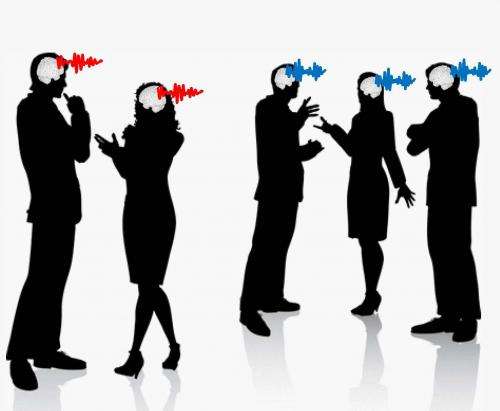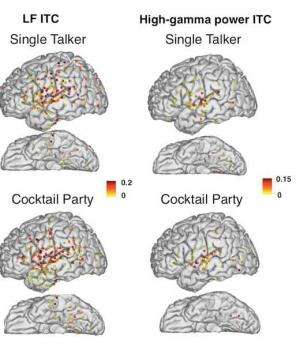Solving the 'Cocktail Party Problem': How we can focus on 1 speaker in noisy crowds

In the din of a crowded room, paying attention to just one speaker's voice can be challenging. Research in the March 6 issue of the Cell Press journal Neuron demonstrates how the brain hones in on one speaker to solve this "Cocktail Party Problem."
Researchers discovered that brain waves are shaped so that the brain can selectively track the sound patterns from the speaker of interest and at the same time exclude competing sounds from other speakers. The findings could have important implications for helping individuals with a range of deficits such as those associated with attention deficit hyperactivity disorder, autism, and aging.
"In hearing, there is no way to 'close your ear,' so all the sounds in the environment are represented in the brain, at least at the sensory level," explains senior author Dr. Charles Schroeder, of Columbia University's Department of Psychiatry. "While confirming this, we also provide the first clear evidence that there may be brain locations in which there is exclusive representation of an attended speech segment, with ignored conversations apparently filtered out." In this way, when concentrating hard on such an "attended" speaker, one is barely, if at all, aware of ignored speakers.

Using direct recording of brain activity in surgical epilepsy patients, who were listening to natural spoken sentences, Dr. Schroeder and Dr. Elana Zion Golumbic, also of Columbia University, and their colleagues from New York University, University of Maryland, and Hillside-Long Island Jewish found two types of effects. In and near auditory cortex, brain signals reflect both attended and ignored speech, but attended speech generates higher signal amplitudes. However, in regions of the brain involved in "higher-order processing," such as language and attention control, representation of attended speech was clear, while that of ignored speech was not detectable. Remarkably, the selective, higher-order representation is progressively refined as a sentence unfolds.
"Most studies use very simplified, unnatural stimuli to study the Cocktail Party Problem—like brief beeps, or even brief phrases—whereas we were able show that with appropriate techniques, we could study this problem using natural speech," says Dr. Schroeder. "This will stimulate future research to continue the study of this and related issues under rich, natural conditions. Just as importantly, the ability to directly analyze widespread brain activity patterns in surgical epilepsy patients provides an unprecedented opportunity to firmly connect the work on the Brain Activity Map at the model systems level in mice, songbirds, and nonhuman primates to the study of capacities like language and music, that may be uniquely human."
More information: Neuron, Zion-Golumbic et al.: "Mechanisms Underlying Selective Neuronal Tracking of Attended Speech at a 'Cocktail Party'." dx.doi.org/10.1016/j.neuron.2012.12.037
















